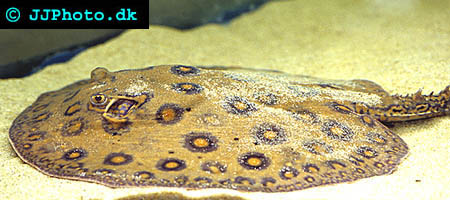Tag Archives: Neotropical Ichthyology
Stirring, charging, and picking: hunting tactics of Brazilian stingrays
If you want to learn more about how the charismatic creatures known as stingrays feed, you should check out a new study published in the most recent issue of Neotropical Ichthyology.
While spending days and nights scuba diving and snorkelling in the upper Paraná River of Brazil, researchers Domingos Garrone-Neto and Ivan Sazima made 132 observations of freshwater stingrays and noticed three different forms of foraging behaviour.
Picture of Motoro Sting Ray, Ocellate river stingray – Potamotrygon motoro.
Copyright www.jjphoto.dk
The first hunting technique involved hovering close to the bottom, or even settle on top of it, while undulating the disc margins. By doing so, the stingray would stir up the substrate, unveiling small invertebrates. The invertebrates – typically snails, crabs and larval insects – could not escape from under the ray’s disc and ended up as food.
When using its second hunting technique, the stingray would slowly approach shallow water while keeping its eyes on suitable prey items that concentrate in such environments. When it got close enough, it would make a rapid attack; stunning the prey or trapping it under its disc. This hunting technique did not target tiny invertebrates hiding in the sand; it focused on tetras and freshwater shrimps instead. The studied stingrays only used this method during the night when they could sneak up on prey without being seen.
The third technique observed relied on the presence of vertical or inclined surfaces in the water, such as boulders and tree stumps, including man-made structures like concrete slabs. On this type of objects a lot of different organisms, e.g. snails, like to crawl around or attach themselves. The hunter would simply position itself with the anterior part of its disc above the water’s edge and start picking the animals off the surface, one at a time.
The two studied species were Potamotrygon falkneri and Potamotrygon motoro; both belonging to a genus of freshwater stingrays found exclusively in South America.
As mentioned above, you can find the paper in Neotropical Ichthyology 7.
Garrone-Neto, D and I Sazima (2009) Stirring, charging, and picking:
hunting tactics of potamotrygonid rays in the upper Paraná River. Neotropical Ichthyology 7, pp. 113–116.
New dirt eater, Gymnogeophagus cichlid has been described.
A new cichlid species has been described from the Río Negro and Río Tacuarí basins in the Uruguay River drainage by Uruguay ichthyologists Iván González-Bergonzoni, Marcelo Loureiro and Sebastián Oviedo.
The fish has been given the name Gymnogeophagus tiraparae (picture here) after María Luisa Tirapare, a Guaraní woman who founded the town of San Borja del Yí (no longer existing) close to one of the collecting localities for this fish.
Gymnogeophagus tiraparae is found in larger rivers with clear water over both sandy and rocky bottoms where underwater vegetation is scarce. The fish is decorated with two horizontal series of moderately elongated light blue dots between the dorsal fin spines, and a series of light blue stripes between the soft rays, sometimes merging with the second series of elongated dots. Between the series of dots, the body of the fish displays a red ground colour. On this spotty fish, the caudal fin is also adorned with dots, which are vertically aligned on the distal border. The body has no transversal bands at all. Another important characteristic is how the adipose hump on the head is located deeper than the upper border of the dorsal fin.
The description was published in the most recent issue of the journal Neotropical ichthyology.
González-Bergonzoni, I, M Loureiro and S Oviedo (2009) A new species of Gymnogeophagus from the río Negro and río Tacuarí basins, Uruguay (Teleostei: Perciformes). Neotropical Ichthyology 7, pp. 19–24.
* Guaraní is a group of culturally related indigenous people of South America who speak the Guaraní language. They are chiefly found between the Paraguay River and the Uruguay River.
New tetra described from Xingu River
A new species of Jupiaba tetra has been described by Brazilian ichtyologists Birindelli, JLO, AM Zanata, LM Sousa and AL Netto-Ferreira.
The fish has been given the name Juipaba kurua, a name derived from the type locality; the Curuá River which is part of the Xingu River drainage. The river name Curuá comes from the tupo language kurua.
Researchers analysed the gut content of these fishes to find out more about their habits and the results indicate that Juipaba kurua is an omnivore clearwater species that feeds along the entire length of the water column.
The faint dark Juipaba kurua is differs from its close relatives by sporting an elongate humeral blotch, a distinct dark spot on the caudal peduncle, and a pattern of dark spots on most of the scales on the sides of the body. The fish has teeth cusps of similar size and the lower jaw teeth gradually decrease in size posteriorly. The number of branched anal-fin rays varies from 21 to 24.
The description of Juipaba kurua was published in the latest issue of the journal Neotropical Ichthyology.
Birindelli, JLO, AM Zanata, LM Sousa and AL Netto-Ferreira (2009) New species of Jupiaba Zanata (Characiformes: Characidae) from Serra do Cachimbo, with comments on the endemism of upper rio Curuá, rio Xingu basin, Brazil. Neotropical Ichthyology 7, pp. 11–18.
